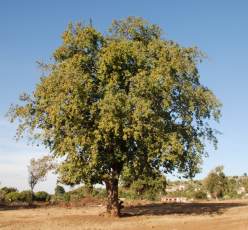Diospyros mespiliformis
Diospyros mespiliformis Hochst. ex A.DC.
Family: Ebenaceae
Common names: African ebony, jackal-berry (Eng.); jakkalsbessie (Afr.); Musuma (Tshivenda); Mgula (Tsonga)
SA Tree No: 606
Introduction
Diospyros mespiliformis has a fantastic mutualism and symbiotic network with many living organisms, from human beings to small insects. There is a complex ecological system revolving around this tree. It is one of the savanna giants that can live for more than 200 years.

Description
Description
Diospyros mespiliformis is a tall, upright tree that can reach a height of 25 m, with a trunk circumference of more than 5 m. It has a dense evergreen canopy. The bark is black to grey, with a rough texture. The fresh inner skin of the bark is reddish. Leaves are simple, alternate, leathery and dark green. The margin is smooth and new leaves in spring are red, especially in young plants. Flowers are cream-coloured and bell-shaped. Male flowers are arranged in stalked bunches and female flowers are solitary. The fruit is a fleshy berry, with an enlarged calyx, yellow to orange when ripe.

Conservation Status
Status
In South Africa the tree is not specifically protected or threatened, but because of its role in the ecosystem and the food web in which it is involved, it definitely deserves some form of protection.
Distribution and habitat
Distribution description
It grows mostly in savanna and woodland, often on termite hills. The tree is widely distributed throughout the eastern part of the African continent, from Ethiopia to the south of Swaziland. It grows well in areas with adequate water and little or no frost.
Derivation of name and historical aspects
History
The genus name Diospyros means divine pear, and the species name mespiliformis according to Venter 1996 is derived from mesos, meaning half and pilos, meaning bullet, referring to the shape of the fruit. Pitman 1972 states the reference is the similarity of the fruit to a medlar. It is the only big tree in its genus. The rest are small shrubby trees, for example D. lycioides, D. austro-africana and D. whyteana. There are other species in the same genus from America and Japan.
Ecology
Ecology
This tree is involved in a unique ecosystem. Different insects such as bees and wasps play a role in pollinating the flowers. Seeds are dispersed either through wash-off by rain or in the droppings of animals that feed on the fruits. Termites often build their nests around the tree and feed on the roots. The tree benefits from moisture and aeration as a result of termites burrowing in the soil under the tree. Snakes like to reside close to or around the tree as they prey on the rodents and certain birds that feed on the fruits.
Some of the animals that feed on the tree are African Green-pigeons, brown-headed parrots, grey hornbills and purple-crested louries, monkeys and baboons. Fallen fruit is eaten by, among others, kudu, impala, nyala and jackal. The leaves are eaten by elephant, kudu and eland. The larvae of the emperor butterfly, Charaxes achaemenes, feed on the leaves of this tree.
Uses
Use
Ripe fruits are relished by indigenous people, especially by children. Fruits are eaten fresh or are dried for later use. The juvenile twigs are sometimes used as toothbrushes. The wood is durable and used to make spoons and canoes. A decoction of roots is ingested to get rid of internal parasites such as worms. Extracts of various parts of the plants are believed to have antibiotic properties. A secondary benefit from this tree is the flavour it gives to termites nesting around the tree. The termites feed on the roots and humans eat the termites, including flying termites, which are delicious. The tree is used for shade and also makes an incredible screen or windbreak.
Growing Diospyros mespiliformis
Grow
Propagate this tree from seed, coppice or root suckers. To break the dormancy, soak seeds in hot water or roast them for a few minutes. In the southern hemisphere the seed must be sown from August to March. Germination is very good. Diospyros mespiliformis prefers moist areas and grows well in red loam soil. It is fairly slow growing and requires plenty of water to speed up the growth rate. Prune off unnecessary shoots to encourage an upright growth form. It is ideal for large gardens and makes an excellent shade tree.
References
- Coates Palgrave, M. 2002. Keith Coates Palgrave Trees of southern Africa, edn 3. Struik, Cape Town.
- Palmer, E. & Pitman, N. 1972. Trees of southern Africa. Balkema, Cape Town.
- Smith, C.A. 1966. Common names of South African plants. Memoirs of the Botanical Survey of South Africa No. 35.
- Venter, F. & Venter, J-A. 1996. Making the most of indigenous trees. Briza Publications, Pretoria.
Credits
Thompson Mutshinyalo
Walter Sisulu National Botanical Garden
August 2007
Plant Attributes:
Plant Type: Tree
SA Distribution: Limpopo, Mpumalanga
Soil type: Sandy, Loam
Flowering season: Spring, Early Summer, Late Summer
PH: Neutral
Flower colour: Cream
Aspect: Full Sun
Gardening skill: Average
Special Features:
Horticultural zones









Rate this article
Article well written and informative
Rate this plant
Is this an interesting plant?
Login to add your Comment
Back to topNot registered yet? Click here to register.